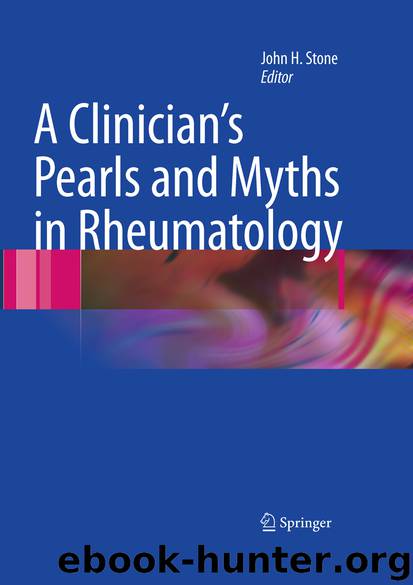A Clinician's Pearls and Myths in Rheumatology by John H. Stone

Author:John H. Stone
Language: eng
Format: epub
Publisher: Springer London, London
Autoinflammatory diseases
Behçet's syndrome
Age group affected
Pediatric
Adult
Areas of highest prevalence
Mostly Europe and North America
Silk Route
Monogenic heritability
Yes
No
Relapsing fever
Very common
Very rare
Disease course
Relentless unless treated
Abates in time
Particular links have been drawn between Behçet's syndrome and the hyper IgD syndrome (Sakane et al. 1999). In fact, IgD levels are not elevated in Behçet's syndrome (Brezniak et al. 1998).
Myth: All clinical manifestations of Behçet's syndrome are caused by vasculitis.
Reality: Many Behçet's syndrome lesions are associated with perivascular inflammation in the absence of true vascular wall destruction. Examples of such manifestations are the oral ulcers, genital lesions, and brain findings (Hirohata 2008). Acne lesions and their associated pustules have also been considered to represent cutaneous vasculitis, but it is now known that they are indistinguishable histo-pathologically from acne vulgaris (Ergun et al. 1998).
Tissue biopsies in Behçet's syndrome generally yield no pathological findings that are pathognomonic of that condition. Clinicians must bear in mind that unless there are compelling reasons for biopsy to exclude other disorders, the diagnosis of Behçet's syndrome usually rests upon its clinical features alone.
Myth: The pustules of Behçet's syndrome are sterile.
Reality: Bacteria are present in the cultures of pustules in Behçet's syndrome patients, just as they are in acne vulgaris (Hatemi et al. 2004). However, the bacteriology of Behçet's syndrome differs from that of acne vulgaris. Staphylococcus aureus, common in the lesions of Behçet's syndrome, is unusual in acne vulgaris.
Knowledge of the bacteriology of non-pustular lesions in Behçet's syndrome remains poorly described. Impairments of innate immunity may explain some of the findings within the acne pustules associated with Behçet's syndrome, including Staphylococcus aureus growth. One piece of evidence supporting defects in innate immunity is the fact that decreased mannose binding lectin levels (MBL) correlate with more severe Behçet's syndrome (Inanc et al. 2005). MBL plays an important role in complement activation and the opsonization of pathogens. Deficiency in this molecule heightens a person's susceptibility to infection.
Myth: The diagnosis of Behçet's syndrome is untenable without a history of oral ulcers.
Reality: Oral ulcers are often viewed as a sine qua non of Behçet's syndrome. Although oral ulcers occur in the overwhelming majority of Behçet's patients, there is a small subset that has classic disease features in every other way but do not manifest oral ulcers.
During the development of the International Study Group's 1990 classification criteria (International Study Group 1990), 28 such patients were identified among the 914 patients included in the study. Thus, 3% of patients diagnosed by Behçet's syndrome experts as having that disorder did not have oral ulcers. At times, some of those patients developed the classic oral lesions, but others remained ulcer-free even as other manifestations of Behçet's syndrome persisted or recurred.
Myth: Tender red lesions that occur on the lower extremities in Behçet's syndrome are inevitably erythema nodosum.
Reality: Erythema nodosum (EN), a septal panniculitis, does occur in Behçet's syndrome and presents as it does in other conditions with tender, nodular lesions. However, the EN of Behçet's syndrome bears some important differences to that observed, for example, in sarcoidosis and inflammatory bowel disease. The following
Download
This site does not store any files on its server. We only index and link to content provided by other sites. Please contact the content providers to delete copyright contents if any and email us, we'll remove relevant links or contents immediately.
Periodization Training for Sports by Tudor Bompa(8171)
Why We Sleep: Unlocking the Power of Sleep and Dreams by Matthew Walker(6618)
Paper Towns by Green John(5092)
The Immortal Life of Henrietta Lacks by Rebecca Skloot(4526)
The Sports Rules Book by Human Kinetics(4296)
Dynamic Alignment Through Imagery by Eric Franklin(4118)
ACSM's Complete Guide to Fitness & Health by ACSM(3989)
Kaplan MCAT Organic Chemistry Review: Created for MCAT 2015 (Kaplan Test Prep) by Kaplan(3940)
Introduction to Kinesiology by Shirl J. Hoffman(3726)
Livewired by David Eagleman(3685)
The Death of the Heart by Elizabeth Bowen(3553)
The River of Consciousness by Oliver Sacks(3542)
Alchemy and Alchemists by C. J. S. Thompson(3451)
Bad Pharma by Ben Goldacre(3357)
Descartes' Error by Antonio Damasio(3230)
The Emperor of All Maladies: A Biography of Cancer by Siddhartha Mukherjee(3068)
The Gene: An Intimate History by Siddhartha Mukherjee(3048)
The Fate of Rome: Climate, Disease, and the End of an Empire (The Princeton History of the Ancient World) by Kyle Harper(3003)
Kaplan MCAT Behavioral Sciences Review: Created for MCAT 2015 (Kaplan Test Prep) by Kaplan(2941)
